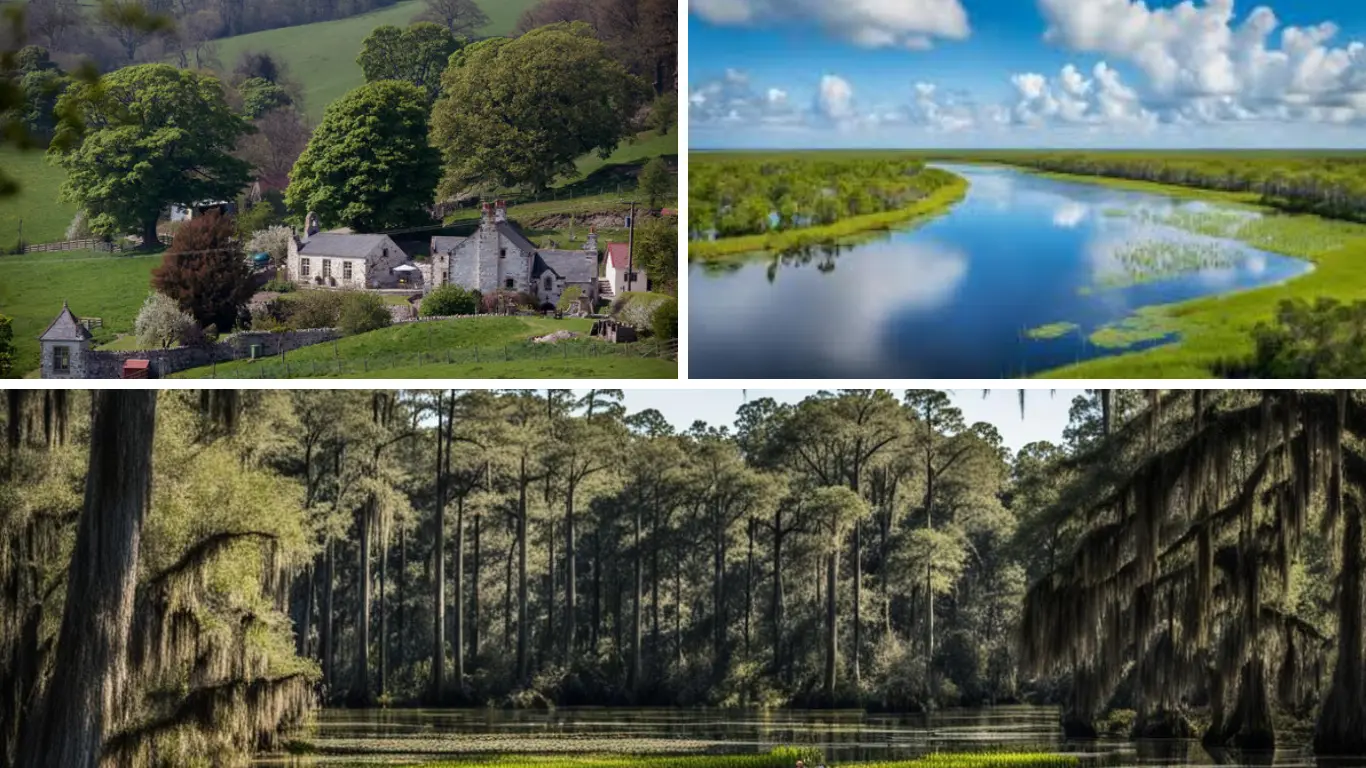The swampy area in the southern US is a captivating landscape full of life and mystery. These wetlands, often shrouded in mist and home to towering cypress trees, offer a unique ecosystem that supports a diverse range of plants and animals. From alligators lurking in the waters to vibrant birds flitting through the trees, the swamp is alive with activity.
Visitors come to explore this enchanting environment, seeking adventure and connection with nature. But beyond its beauty, the swamp plays a crucial role in the health of our planet. It filters water, absorbs floodwaters, and provides habitat for countless species. This article invites you to delve into the wonders of the Swampy Area in the Southern US Nyt, highlighting its ecological significance, cultural importance, and the joy it brings to those who experience it. Join us as we journey through this natural wonderland!
What Is a Swamp?
A swamp is a type of wetland that features a unique mix of water, soil, and vegetation. Unlike lakes or rivers, swamps have standing water, which can vary in depth. They are typically dominated by trees and shrubs, making them lush and green. Swamps can be found in many regions, but the Swampy Area in the Southern US Nyt is particularly well-known for its rich biodiversity.
Swamps serve several important functions in the ecosystem. They act as natural filters, removing pollutants from water before it flows into rivers and lakes. They also provide crucial habitat for wildlife, including many species of birds, reptiles, and amphibians. The waterlogged soil in swamps is rich in nutrients, supporting a variety of plants and fostering a complex food web.
In addition to their ecological importance, swamps have cultural significance. Many Indigenous peoples have lived in harmony with these wetlands for generations, relying on their resources for food and medicine. Understanding what a swamp is and its role in the environment helps us appreciate these fascinating landscapes and the life they support.
The Geography of Southern Swamps
The geography of southern swamps is marked by unique features that distinguish them from other wetland types. These areas typically have slow-moving or stagnant water, which can be influenced by seasonal rainfall and nearby rivers. The soil is often rich in organic matter, creating a fertile environment for various plant species.
In the southern US, some of the most notable swamps include:
- The Everglades: Located in Florida, this vast wetland is famous for its diverse ecosystems, including sawgrass marshes and mangroves. It serves as a critical habitat for many endangered species.
- Okefenokee Swamp: Spanning Georgia and Florida, the Okefenokee is one of the largest blackwater swamps in North America. Its dark waters are rich in tannins, giving it a unique appearance and supporting a variety of wildlife.
- Atchafalaya Basin: Situated in Louisiana, this swamp is the largest in the United States and is known for its intricate network of bayous, rivers, and wetlands. It plays a vital role in flood control and supports a rich array of fish and bird species.
Southern swamps are characterized by their dense vegetation, which includes cypress trees, tupelo trees, and various aquatic plants. The interplay of water and land creates a mosaic of habitats that attract countless species. This unique geography not only contributes to the beauty of the landscape but also plays a crucial role in the overall health of the ecosystem. Understanding the geography of these swamps helps us appreciate their significance and the life they nurture.
Biodiversity in Southern Swamps
Biodiversity in southern swamps is incredibly rich and varied, making these ecosystems some of the most vibrant on the planet. The unique combination of water, soil, and plant life creates a habitat that supports an array of species, each playing a vital role in the ecosystem.
Flora
The plant life in southern swamps is diverse, featuring a mix of trees, shrubs, and aquatic plants. Key species include:
- Cypress Trees: Iconic to swamp landscapes, these trees have distinctive knobby roots that help stabilize the soil and provide habitat for wildlife.
- Tupelo Trees: These trees thrive in wet conditions and produce sweet, nutritious fruits that attract various animals.
- Water Lilies: Floating on the surface, these beautiful flowers provide food and shelter for fish and amphibians.
Fauna
The animal life in southern swamps is equally impressive. Common species include:
- Alligators: As apex predators, alligators help maintain the balance of the ecosystem by controlling fish and bird populations.
- Birds: The swamp is home to numerous bird species, including herons, egrets, and woodpeckers. Many of these birds rely on the wetlands for nesting and feeding.
- Reptiles and Amphibians: The humid environment is perfect for various snakes, frogs, and turtles, all of which contribute to the swamp’s biodiversity.
Importance of Biodiversity
The high levels of biodiversity found in southern swamps provide numerous benefits. These ecosystems support a complex food web, where each species interacts with others in various ways. This interconnectedness helps to stabilize the environment and ensures resilience against changes, such as climate fluctuations.
Furthermore, the biodiversity in these swamps contributes to ecological services like water filtration, flood control, and carbon storage. Protecting this rich variety of life is crucial for maintaining the health of the ecosystem and the overall environment. By understanding and appreciating the biodiversity in southern swamps, we can better advocate for their preservation and the many benefits they provide.
The Importance of Swamps
Swamps are vital ecosystems that offer numerous benefits to the environment and society. Their unique characteristics make them essential for ecological balance, flood control, and biodiversity.
Water Filtration
One of the primary functions of swamps is their ability to filter water. The dense vegetation and rich soil trap sediments and pollutants, preventing them from entering rivers and lakes. This natural filtration process improves water quality and protects downstream ecosystems.
Flood Control
Swamps play a crucial role in managing floodwaters. During heavy rains, they absorb excess water, reducing the impact of flooding on nearby communities. This capacity to store water helps prevent erosion and protects infrastructure.
Biodiversity Habitat
Swamps are home to a rich diversity of plant and animal species. They provide critical habitat for many endangered species, making them essential for conservation efforts. The variety of habitats within swamps supports intricate food webs and ecological interactions.
Carbon Storage
Wetlands, including swamps, are significant carbon sinks. They store carbon dioxide, helping to mitigate climate change. The peat and organic matter in swamp soils trap carbon, preventing it from being released into the atmosphere.
Recreational Opportunities
Swamps offer a wealth of recreational activities, such as kayaking, fishing, and birdwatching. These activities not only enhance quality of life but also promote ecotourism, supporting local economies.
Cultural Significance
Many communities have deep cultural ties to swamps. Indigenous peoples have relied on these ecosystems for food, medicine, and spiritual practices for generations. Recognizing and respecting this cultural significance is crucial for conservation efforts.
Ecotourism in Southern Swamps
Ecotourism has become increasingly popular in southern swamps, drawing nature enthusiasts from around the world. Visitors are eager to explore the unique landscapes and wildlife these ecosystems offer. Activities like guided tours, kayaking, and birdwatching allow people to connect with nature while promoting conservation.
Local businesses often thrive on ecotourism, providing jobs and supporting the economy. Tourists are educated about the importance of preserving these habitats, fostering a sense of stewardship. By choosing ecotourism, visitors contribute to the protection of the Swampy Area in the Southern US Nyt, ensuring its beauty and biodiversity for future generations.
Conservation Efforts
Conservation efforts in southern swamps focus on protecting and restoring these vital ecosystems. Various organizations work tirelessly to address issues like habitat loss, pollution, and climate change. Initiatives often include:
- Restoration Projects: Rehabilitating degraded areas helps restore natural habitats and improve water quality.
- Public Awareness Campaigns: Educating communities about the importance of swamps encourages responsible behavior and support for conservation initiatives.
- Policy Advocacy: Working with local and state governments to create policies that protect wetland areas is essential for long-term conservation.
These efforts aim to preserve the Swampy Area in the Southern US Nyt, ensuring its health and vitality for years to come.
Challenges Facing Swamps
Despite their importance, swamps face numerous challenges. Some of the most significant threats include:
- Urban Development: Expanding cities often encroach on wetland areas, leading to habitat loss and fragmentation.
- Pollution: Runoff from agriculture and industry can introduce harmful chemicals into swamp ecosystems, threatening wildlife and water quality.
- Climate Change: Rising sea levels and changing weather patterns can alter the delicate balance of these habitats, making them more vulnerable to flooding and erosion.
Addressing these challenges is critical for the survival of southern swamps. Public awareness and proactive conservation measures are necessary to protect these vital ecosystems.
How to Explore the Swampy Area
Exploring the Swampy Area in the Southern US Nyt offers a range of exciting activities:
- Guided Tours: Many companies provide knowledgeable guides who share insights into the ecology and history of the swamps.
- Kayaking and Canoeing: Paddling through the calm waters allows for close encounters with wildlife while enjoying the serene beauty of the landscape.
- Hiking Trails: Various trails wind through swampy regions, offering opportunities to observe the flora and fauna up close.
- Birdwatching: Bring binoculars to spot diverse bird species, making it a rewarding experience for both amateur and seasoned birdwatchers.
Engaging in these activities allows visitors to appreciate the wonders of the swamp while promoting conservation.
Local Cuisine
The Swampy Area in the Southern US Nyt has a rich culinary heritage influenced by its natural resources. Local cuisine often features ingredients sourced from the wetlands. Some popular dishes include:
- Gumbo: A hearty stew made with seafood, sausage, and a variety of spices, reflecting the cultural blend of the region.
- Fried Catfish: Fresh catfish from local waters is a beloved dish, often served with sides like coleslaw and hushpuppies.
- Crawfish Étouffée: This dish showcases crawfish, a staple of southern cuisine, cooked in a flavorful sauce and served over rice.
Dining on these local dishes not only offers a taste of the region but also connects diners to the rich ecosystem that provides these ingredients.
Cultural Significance
The Swampy Area in the Southern US Nyt holds deep cultural significance for many communities. Indigenous peoples have lived in and around these wetlands for generations, relying on their resources for food, medicine, and cultural practices. The stories, traditions, and knowledge passed down through generations highlight the importance of swamps in shaping cultural identity.
Additionally, the unique landscape inspires art, music, and folklore, reflecting the connection people have with their environment. Understanding the cultural significance of swamps enhances our appreciation of these ecosystems and reinforces the need for their protection. Embracing this cultural heritage ensures that future generations can continue to learn from and connect with the Swampy Area in the Southern US Nyt.
Conclusion
The Swampy Area in the Southern US Nyt is a treasure trove of biodiversity and natural beauty. Its unique ecosystems play crucial roles in water filtration, flood control, and carbon storage, benefiting both the environment and human communities. By understanding the importance of swamps, we can appreciate the intricate balance of life they support. The rich cultural heritage associated with these wetlands adds another layer of significance, reminding us of our connection to nature.
As we face increasing challenges like climate change and urban development, the need for conservation has never been more urgent. Engaging in ecotourism, supporting local conservation efforts, and embracing sustainable practices are vital steps we can take. By valuing and protecting the Swampy Area in the Southern US Nyt, we ensure that its wonders continue to thrive for generations to come. Let’s commit to preserving these vital ecosystems and the diverse life they nurture, celebrating the beauty and complexity of our natural world.
| Visit my homepage for more information, articles, and news. |
Frequently Asked Questions – FAQs
What types of ecosystems can be found in southern swamps?
Southern swamps are primarily characterized by wetlands, which include freshwater swamps, marshes, and bogs. These ecosystems feature a variety of plant life, such as cypress trees, water lilies, and various grasses. The diverse habitats support a wide range of wildlife, including birds, alligators, frogs, and many fish species. Each type of swamp has unique characteristics, but they all share the common feature of being waterlogged for part or most of the year. The Swampy Area in the Southern US Nyt is renowned for its rich biodiversity and vital role in supporting both nature and local cultures.
How do swamps help in flood control?
Swamps play a crucial role in managing floodwaters. In the swampy area in the southern US Nyt, their sponge-like soils can absorb and store large amounts of water during heavy rainfall. This capacity helps to reduce the speed and volume of water flowing into rivers and lakes, mitigating the impact of flooding on nearby communities. By acting as natural buffers, swamps protect infrastructure and preserve the surrounding ecosystems from erosion and damage.
What recreational activities can I enjoy in southern swamps?
Visitors to the Swampy Area in the Southern US Nyt can engage in a variety of recreational activities. Popular options include guided boat tours, kayaking, birdwatching, and hiking on designated trails. These activities allow participants to explore the unique landscapes and observe the diverse wildlife that inhabits these wetlands. Many ecotourism companies also offer educational programs to enhance the experience, providing insights into the ecology and cultural significance of the Swampy Area in the Southern US Nyt.
What conservation efforts are in place to protect southern swamps?
Numerous organizations and initiatives focus on the conservation of southern swamps. Efforts include habitat restoration projects, pollution control measures, and public awareness campaigns aimed at educating communities about the importance of these ecosystems. Additionally, advocacy for protective legislation helps ensure that wetlands are safeguarded from urban development and environmental degradation. Collaboration among local governments, nonprofits, and the public is crucial to the success of these conservation efforts.
Why is the cultural significance of southern swamps important?
The cultural significance of southern swamps is profound, particularly for Indigenous peoples who have historically relied on these ecosystems for sustenance and spirituality. The knowledge, traditions, and practices associated with the swamp contribute to a sense of identity and heritage. By recognizing and respecting this cultural connection, we can foster a greater appreciation for the natural world and promote conservation efforts that honor the voices and values of local communities. Understanding this significance enriches our relationship with the environment and underscores the need to protect these vital ecosystems.




